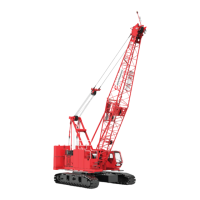Manitowoc Published 10-09-2020, Control # 259-06 5-13
MLC80A-1/MLC90A-1/MLC100A-1/MLC100-1 SERVICE/MAINTENANCE MANUAL HOISTS
DRUM 4
See Figure 5-8 and Figure 5-9.
The hydraulic circuit for Drum 4 consists of an independently
controlled 107cc rotary group (Pump B) of the main pump,
an electrically-operated directional control valve, and an
80cc fixed displacement motor with dual-sided holding valve
to allow for additional charge pressure to be supplied from
the pilot circuit for travel on grade. The control signals to
these hydraulic elements are determined by the CCS, which
uses a number of inputs and to determine speed, direction,
and brake release commands.
Drum 4 Pawl
See Figure 5-16.
The Drum 4 pawl is controlled by a 3-position solenoid valve
that receives oil flow from the accessory pump.
When the Drum 4 park switch is in the parked position, the
CCS shifts the pawl valve to the position that extends the
pawl cylinder (rotates cam away from pawl), allowing the
pawl to spring engage the drum ratchet.
When the Drum 4 park switch is in the un-parked position,
the CCS shifts the pawl valve to the position that retracts the
pawl cylinder, allowing the cam to disengage the pawl from
the drum ratchet.
The limit switch signals the CCS that the pawl is disengaged.
Holding Valve
A holding valve is attached to the motor. The purpose of the
valve is to:
• Ensure that the hoist powers down properly
• Hold the load when the control handle is in center
• Ensure smooth starts, stops, and changes in hoist
speed
• Relieve momentary excess pressure that may occur
when bringing a heavy load to a quick stop.
The valve functions differently in each direction:
Lowering and Holding a Load
When flow is in the lowering direction, the holding valve
functions as a hydraulically operated proportional spool
valve which checks motor outflow in one position and in the
other position allows motor outflow.
When there is no working pressure (handle in center), a
check valve halts hydraulic flow in the return side of the
down circuit. This prevents the hoist motor from turning in
the down direction. As the control handle is moved off center
in the down direction, the working pressure begins to act on
the valve, which begins to shift to the lowering unchecked
position to allow motor outflow.
When the control handle is moved toward center, the holding
valve begins to close, slowing the load. At center, the check
valve is again closed, preventing motor outflow and
downward movement of the load. An orifice in the circuit
prevents abruptness in starting and changes in hoist speed.
Pilot-Operated Relief Valve
The relief valve in the motor protects the motor from
excessive pressure, such as might occur when bringing a
heavy load to a quick stop when lowering.
Raising a Load
When system flow is in the raising direction, the holding
valve functions as a hydraulically operated proportional
spool valve which checks motor outflow in one position and
in the other position allows motor outflow.
When there is no working pressure (handle in center), a
check valve halts hydraulic flow in the return side of the
down circuit. This prevents the hoist motor from turning in
the down direction. As the control handle is moved off center
in the up direction, the working pressure begins to act on the
valve, which begins to shift to the raising unchecked position
to allow motor outflow. When the control handle is moved
toward center, the holding valve begins to close, slowing the
load. At center, the check valve is again closed, preventing
motor outflow and downward movement of the load.
An orifice in the circuit prevents abruptness in starting and
changes in hoist speed.

